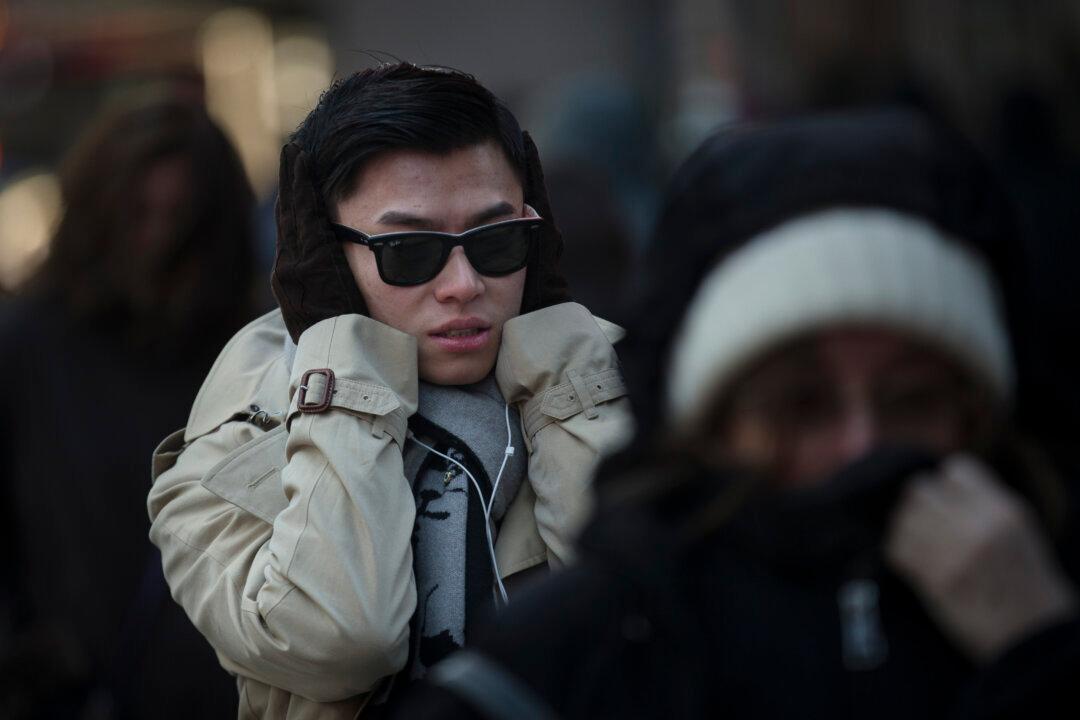Dangerously cold temperatures besetting New York City since Thursday night will continue on Friday night. It has been forecasted that “a wintry mix of snow, sleet, freezing rain, and rain are expected Saturday through Sunday afternoon,” warned the New York City Office of Emergency Management in a Friday alert.
Temperatures Friday night are expected to drop to 10 degrees Fahrenheit with wind chills near 5 degrees Fahrenheit. Temperatures will rise to approximately 32 degrees Fahrenheit on Saturday, with wind chills between zero and 10 degrees. On Sunday it will warm up to 40 degrees, with wind chills between 20 and 25 degrees Fahrenheit.
“New Yorkers are asked to exercise caution during this period of extreme cold weather, and be prepared for slippery conditions, as freezing rain could cause icy conditions Sunday,” the alert states. “Seniors, infants, the homeless, and those with chronic medical conditions are at increased risk of health problems from the cold.”
It is also good to note that Alternate Side Parking rules are suspended Friday, February 20 and Saturday, February 21. Parking meters remain in effect throughout the city.
The alert also included the following announcements and suggestions:
Safety Tips
1. Prolonged exposure to extreme cold weather can be dangerous. If you suspect a person is suffering from frostbite or hypothermia, call 911 to get medical help. While waiting for assistance, help the person by getting them to a warm place if possible, removing any damp clothing and covering them with warm blankets.
2. Stay indoors as much as possible.
3. Wear a hat, hood, or scarf, as most heat is lost through the head.
4. Keep fingertips, earlobes, and noses covered if you go outside.
5. When outdoors, wear warm clothing and cover exposed skin. Use multiple layers to maintain warmth.
6. Keep clothing dry; if a layer becomes wet, remove it.
7. Wear sturdy boots that provide traction to reduce slipping. Use handrails when using stairs.
8. Exercise caution and avoid slippery surfaces; some ice may not be visible.
9. Workers in construction and utilities, and others who spend a lot of time outdoors are at risk for cold-related disorders. Employers should implement safe work practices, provide appropriate protective equipment, and train workers on health effects of cold weather, proper prevention techniques, and treatment of cold-related disorders.
10. Have heightened awareness of cars, particularly when approaching or crossing intersections.
Homeless Services
11. Special protocols are in effect when the temperature drops below 32 degrees. No one seeking shelter in New York City will be denied.
12. Anyone who sees a homeless individual or family out in the cold should call 311 immediately and an outreach team will be dispatched to assist them.
Most Vulnerable
13. Shivering is an important first sign that the body is losing heat. Shivering is a signal to return indoors.
14. People most likely to be exposed to dangerous cold include those who lack shelter, work outdoors, and/or live in homes with malfunctioning or inadequate heat.
15. New Yorkers are advised to check on their neighbors, friends, and relatives—especially the elderly and those with disabilities and access and functional needs.
16. Drinking alcohol may make you think you feel warmer but actually increases your chances of hypothermia and frostbite.
17. Seniors, infants, people with chronic cardiovascular or lung conditions, people using alcohol or drugs, and people with cognitive impairments such as dementia, serious mental illness, or developmental disability are at increased risk.
18. Seniors should take extra care outdoors to avoid slips and falls from icy conditions.
19. Cold weather puts an extra strain on the heart. If you have heart disease or high blood pressure, follow your doctor’s advice about shoveling snow or performing other hard work in the cold. Remember, your body is already working hard just to stay warm, so don’t overdo it.
Heating Tips
20. Report any loss of heat or hot water to property managers immediately, and call 311.
21. Never use a gas stove to heat your home. Carbon monoxide is colorless and odorless and over time will build up in your blood causing symptoms that can easily be mistaken for the flu—headaches, fatigue, nausea, and drowsiness. Sometimes your pets will show symptoms first. If more than one person in your family is showing symptoms, call 911.
22. Never use a kerosene or propane space heater, charcoal or gas grill, or generator indoors or near the home.
23. Electric space heaters are the only kind of space heater legal in New York City and should turn off automatically when tipped over, and should be kept far from combustible and flammable objects, as well as water.
For Motorists
24. Drive slowly. Posted speed limits are for ideal weather conditions. Vehicles take longer to stop on snow and ice than on dry pavement.
25. Use major streets or highways for travel whenever possible; these roadways will be cleared first.
26. Four-wheel-drive vehicles may make it easier to drive on snow-covered roads, but they do not stop quicker than other vehicles.
27. Keep the name and phone number of at least one local towing service in your car in case you break down or become stuck in snow.
28. If you get stuck on the road, stay with your car and contact a towing company.





